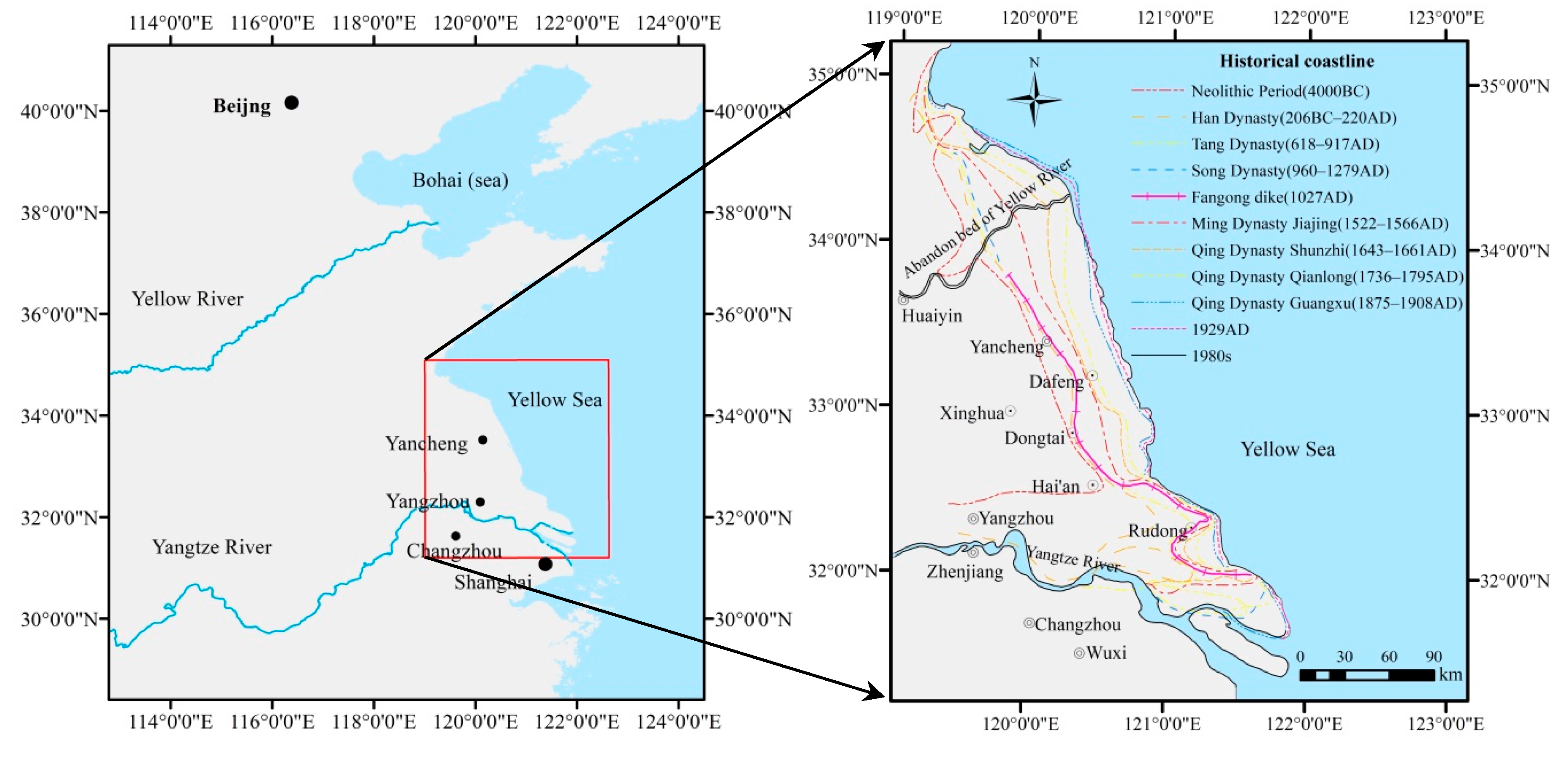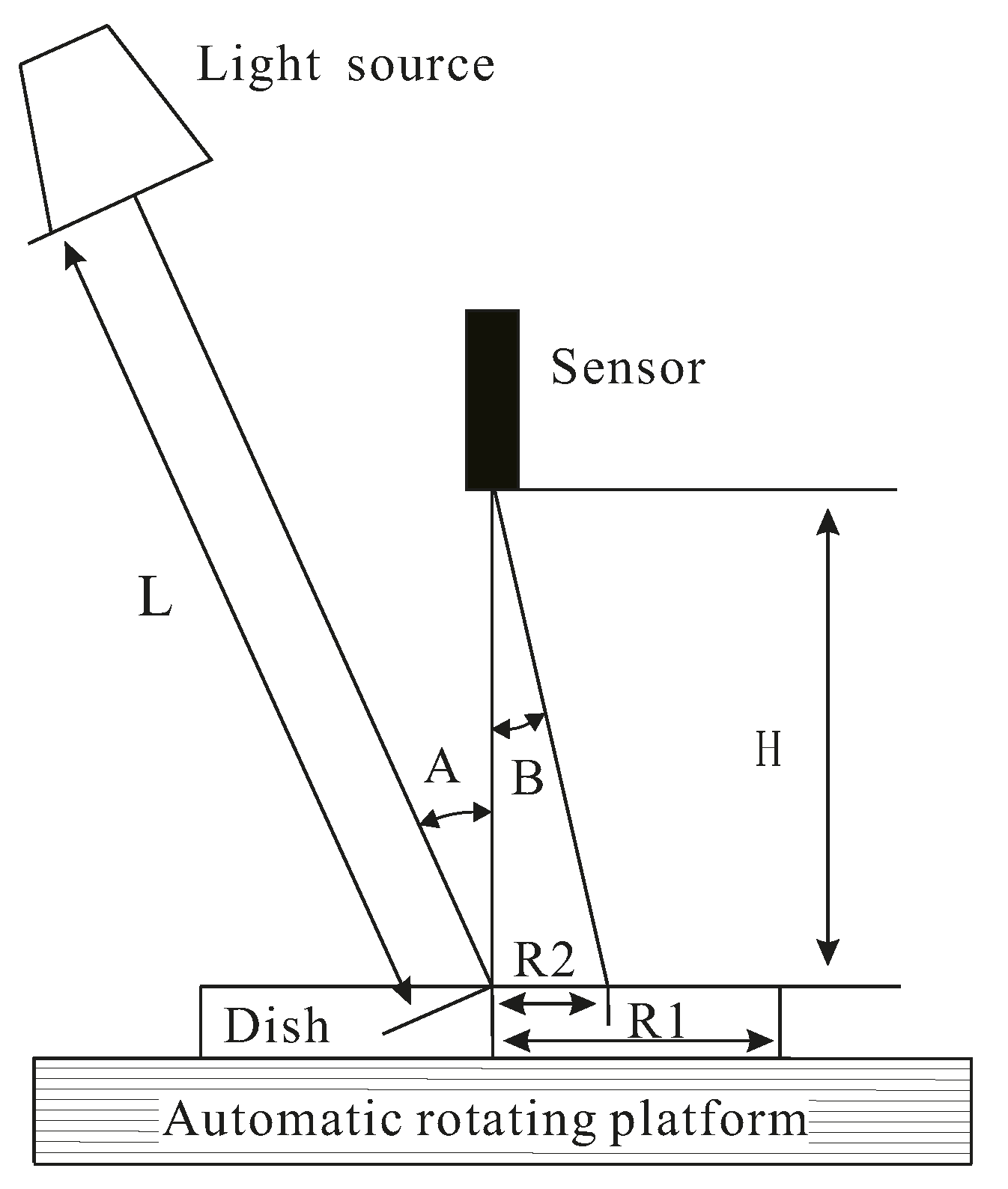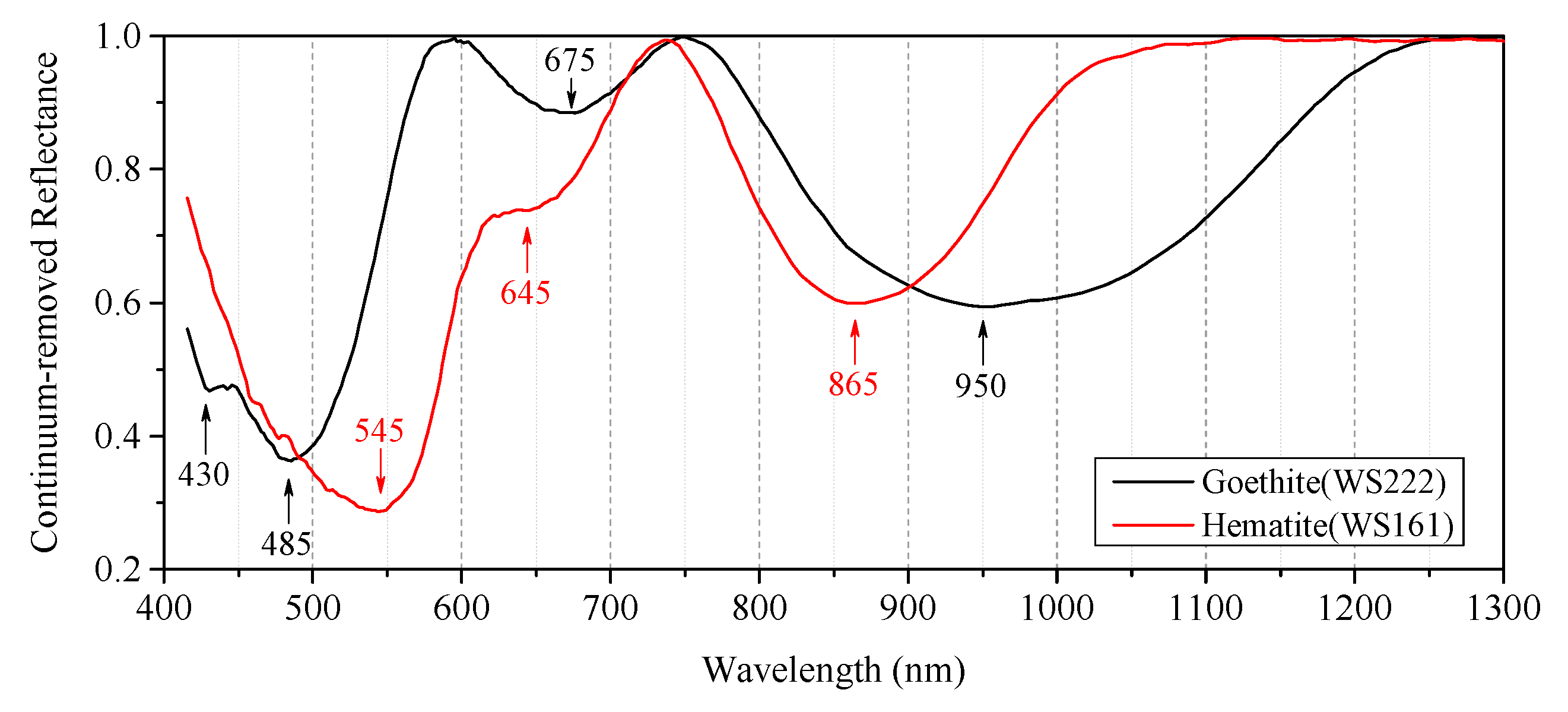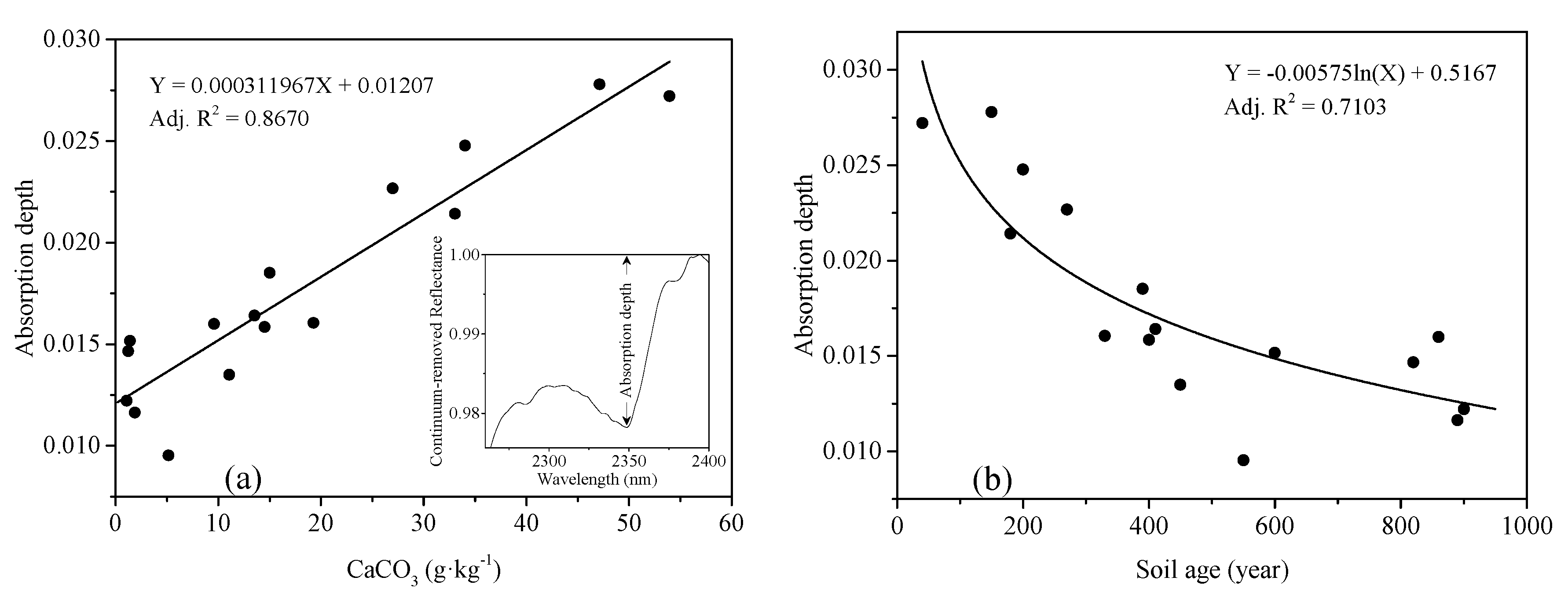Visible and Near-Infrared Reflectance Spectroscopy Analysis of a Coastal Soil Chronosequence
Abstract
:1. Introduction
2. Materials and Methods
2.1. Study Area and Soil Formation
2.2. Soil Sampling and Analysis
2.3. Spectra Determination
2.4. Statistical Analysis and Transformation of the Spectral Data
2.5. Datasets Partitioning and Accuracy Evaluating
3. Results
3.1. Basic Statistics of Soil Properties
3.2. Soil Property Changes in Chronosequence and Pedogenic Interpretations
3.3. Spectroscopy Analysis of Top Soil
3.4. Soil Property Predictions
3.5. Soil Age Calibration Using Spectra From Multiple Depths
4. Discussion
4.1. Reflectance Spectroscopy and Soil Genesis
4.2. Combination of Horizontal Spectroscopy
4.3. Limitation of Research
5. Conclusions
Author Contributions
Funding
Acknowledgments
Conflicts of Interest
References
- Jenny, H. Factors of Soil Formation: A System of Quantitative Pedology, 1st ed.; McGraw-Hill: New York, NY, USA, 1941. [Google Scholar]
- Stevens, P.R.; Walker, T.W. The chronosequence concept and soil formation. Q. Rev. Biol. 1970, 45, 333–350. [Google Scholar] [CrossRef]
- Yaalon, D.H. Climate, time and soil development. In Pedogenesis and Soil Taxonomy: I. Concepts and Interactions, 1st ed.; Wilding, L.P., Smeck, N.E., Hall, G.F., Eds.; Elsevier: Amsterdam, The Netherlands, 1983; pp. 223–251. [Google Scholar]
- Jenny, H. The Soil Resource: Origin and Behaviour, 1st ed; Springer: New York, NY, USA, 1980. [Google Scholar]
- Huggett, R.J. Soil chronosequences, soil development, and soil evolution: A critical review. Catena 1998, 32, 155–172. [Google Scholar] [CrossRef]
- Huang, L.M.; Thompson, A.; Zhang, G.L.; Chen, L.M.; Han, G.Z.; Gong, Z.T. The use of chronosequences in studies of paddy soil evolution: A review. Geoderma 2015, 237–238, 199–210. [Google Scholar] [CrossRef]
- Fu, Q.L.; Ding, N.F.; Liu, C.; Lin, Y.C.; Guo, B. Soil development under different cropping systems in a reclaimed coastal soil chronosequence. Geoderma 2014, 230–231, 50–57. [Google Scholar] [CrossRef]
- Vilmundardóttir, O.K.; Gísladóttir, G.; Lal, R. Soil carbon accretion along an age chronosequence formed by the retreat of the Skaftafellsjökull glacier, SE-Iceland. Geomorphology 2015, 228, 124–133. [Google Scholar] [CrossRef]
- Schwertmann, U. The effect of pedogenic environments on iron oxide minerals. In Advances in Soil Science, 1st ed.; Stewart, B.A., Ed.; Springer: New York, NY, USA, 1985; pp. 171–200. [Google Scholar]
- Huang, W.S.; Jien, S.H.; Tsai, H.; Hseu, Z.Y.; Huang, S.T. Soil evolution in a tropical climate: An example from a chronosequence on marine terraces in Taiwan. Catena 2016, 139, 61–72. [Google Scholar] [CrossRef]
- He, Y.; Li, D.C.; Velde, B.; Yang, Y.F.; Huang, C.M.; Gong, Z.T.; Zhang, G.L. Clay minerals in a soil chronosequence derived from basalt on Hainan Island, China and its implication for pedogenesis. Geoderma 2008, 148, 206–212. [Google Scholar] [CrossRef]
- Torrent, J.; Nettleton, W.D. A simple textural index for assessing chemical weathering in soils. Soil Sci. Soc. Am. J. 1979, 43, 373–377. [Google Scholar] [CrossRef]
- Vidic, N.J.; Lobnlk, F. Rates of soil development of the chronosequence in the Ljubljana Basin, Slovenia. Geoderma 1997, 76, 35–64. [Google Scholar] [CrossRef]
- Scarciglia, F.; Pelle, T.; Pulice, I.; Robustelli, G. A comparison of quaternary soil chronosequences from the ionian and tyrrhenian coasts of calabria, southern italy: Rates of soil development and geomorphic dynamics. Quatern. Int. 2015, 376, 146–162. [Google Scholar] [CrossRef]
- Merritts, D.J.; Chadwick, O.A.; Hendricks, D.M. Rates and processes of soil evolution on uplifted marine terraces, northern California. Geoderma 1991, 51, 241–275. [Google Scholar] [CrossRef]
- Schaetzl, R.J.; Anderson, S. Soils: Genesis and Geomorphology, 1st ed.; Cambridge University Press: New York, NY, USA, 2005. [Google Scholar]
- Viscarra Rossel, R.A.; Walvoort, D.J.J.; McBratney, A.B.; Janik, L.J.; Skjemstad, J.O. Visible, near infrared, mid infrared or combined diffuse reflectance spectroscopy for simultaneous assessment of various soil properties. Geoderma 2006, 131, 59–75. [Google Scholar] [CrossRef]
- Bowers, S.A.; Hanks, R.J. Reflectance of radiant energy from soils. Soil Sci. 1965, 100, 130–138. [Google Scholar] [CrossRef]
- Condit, H.R. The spectral reflectance of American soils. Photogramm. Eng. 1970, 36, 955–966. [Google Scholar]
- Stenberg, B.; Viscarra Rossel, R.A.; Mouazen, A.M.; Wetterlind, J.; Donald, L.S. Visible and near infrared spectroscopy in soil science. Adv. Agron. 2010, 107, 163–215. [Google Scholar] [CrossRef]
- Viscarra Rossel, R.A.; Lobsey, C.R.; Sharman, C.; Flick, P.; McLachlan, G. Novel soil profile sensing to monitor organic C stocks and condition. Environ. Sci. Technol. 2017, 51, 5630–5641. [Google Scholar] [CrossRef]
- Demattê, J.A.M.; Fongaro, C.T.; Rizzo, R.; Safanelli, J.L. Geospatial Soil Sensing System (GEOS3): A powerful data mining procedure to retrieve soil spectral reflectance from satellite images. Remote Sens. Environ. 2018, 212, 161–175. [Google Scholar] [CrossRef]
- Peng, J.; Biswas, A.; Jiang, Q.S.; Zhao, R.Y.; Hu, J.; Hu, B.F.; Shi, Z. Estimating soil salinity from remote sensing and terrain data in southern Xinjiang Province, China. Geoderma 2019, 337, 1309–1319. [Google Scholar] [CrossRef]
- Demattê, J.A.M.; Garcia, G.J. Alteration of soil properties through a weathering sequence as evaluated by spectral reflectance. Soil Sci. Soc. Am. J. 1999, 63, 327–342. [Google Scholar] [CrossRef]
- Ben-Dor, E.; Levin, N.; Singer, A.; Karnieli, A.; Braun, O.; Kidron, G.J. Quantitative mapping of the soil rubification process on sand dunes using an airborne hyperspectral sensor. Geoderma 2006, 131, 1–21. [Google Scholar] [CrossRef]
- Demattê, J.A.M.; Horák-Terra, I.; Beirigo, R.M.; Terra, F.S.; Marques, K.P.P.; Fongaro, C.T.; Silva, A.C.; Vidal-Torrado, P. Genesis and properties of wetland soils by VIS-NIR-SWIR as a technique for environmental monitoring. J. Environ. Manage. 2017, 197, 50–62. [Google Scholar] [CrossRef]
- Terra, F.S.; Demattê, J.A.M.; Viscarra Rossel, R.A. Proximal spectral sensing in pedological assessments: Vis–NIR spectra for soil classification based on weathering and pedogenesis. Geoderma 2018, 318, 123–136. [Google Scholar] [CrossRef]
- Demattê, J.A.M.; Terra, F.D.S. Spectral pedology: A new perspective on evaluation of soils along pedogenetic alterations. Geoderma 2014, 217–218, 190–200. [Google Scholar] [CrossRef]
- Zheng, G.H.; Jiao, C.X.; Zhou, S.L.; Shang, G. Analysis of soil chronosequence studies using reflectance spectroscopy. Int. J. Remote Sens. 2016, 37, 1881–1901. [Google Scholar] [CrossRef]
- Awiti, A.O.; Walsh, M.G.; Shepherd, W.K.; Kinyamario, J. Soil condition classification using infrared spectroscopy: A proposition for assessment of soil condition along a tropical forest-cropland chronosequence. Geoderma 2008, 143, 73–84. [Google Scholar] [CrossRef]
- Chen, L.M.; Zhang, G.L.; Effland, W.R. Soil characteristic response times and pedogenic thresholds during the 1000-year evolution of a paddy soil chronosequence. Soil Sci. Soc. Am. J. 2011, 75, 1807–1820. [Google Scholar] [CrossRef]
- Cui, J.; Liu, C.; Li, Z.L.; Wang, L.; Chen, X.F.; Ye, Z.Z.; Fang, C.M. Long-term changes in topsoil chemical properties under centuries of cultivation after reclamation of coastal wetlands in the Yangtze Estuary, China. Soil Till Res. 2012, 123, 50–60. [Google Scholar] [CrossRef]
- Zhang, R.S. Land-forming history of the Huanghe River delta and coastal plain of north Jiangsu. Acta Geogr. Sin. 1984, 39, 173–184. [Google Scholar]
- Lu, R.K. Chemical Analysis of Agricultural Soil, 1st ed.; China Agricultural Science and Technology Press: Beijing, China, 1999. [Google Scholar]
- Viscarra Rossel, R.A.; Behrens, T. Using data mining to model and interpret soil diffuse reflectance spectra. Geoderma 2010, 158, 46–54. [Google Scholar] [CrossRef]
- Wold, S.; Martens, H.; Wold, H. The multivariate calibration method in chemistry solved by the PLS method. In Lecture Notes in Mathematics; Kågström, B., Ruhe, A., Eds.; Springer: Heidelberg, German, 1983; pp. 286–293. [Google Scholar] [CrossRef]
- Dangal, S.R.S.; Sanderman, J.; Wills, S.; Ramirez-Lopez, L. Accurate and precise prediction of soil properties from a large mid-infrared spectral library. Soil Syst. 2019, 3, 11. [Google Scholar] [CrossRef]
- Clark, R.N.; Roush, T.L. Reflectance spectroscopy: Quantitative analysis techniques for remote sensing applications. J. Geophys. Res. 1984, 89, 6329–6340. [Google Scholar] [CrossRef]
- Viscarra Rossel, R.A.; Cattle, S.R.; Ortega, S.R.; Fouad, Y. In situ measurements of soil colour, mineral composition and clay content by vis-NIR spectroscopy. Geoderma 2009, 150, 253–266. [Google Scholar] [CrossRef]
- Savitzky, A.; Golay, M.J.E. Smoothing and differentiation of data by simplified least squares procedures. Anal. Chem. 1964, 36, 1627–1639. [Google Scholar] [CrossRef]
- Vasques, G.M.; Demattê, J.A.M.; Viscarra Rossel, R.A.; Ramírez-López, L.; Terra, F.S. Soil classification using visible/near-infrared diffuse reflectance spectra from multiple depths. Geoderma 2014, 223–225, 73–78. [Google Scholar] [CrossRef]
- Minasny, B.; Stockmann, U.; Hartemink, A.E.; McBratney, A.B. Measuring and modelling soil depth functions. In Digital Soil Morphometrics; Hartemink, E.A., Minasny, B., Eds.; Springer: Cham, Switzerland, 2016; pp. 225–240. [Google Scholar] [CrossRef]
- Brauer, T.; Grootes, P.M.; Nadeau, M.J.; Andersen, N. Downward carbon transport in a 2000-year rice paddy soil chronosequence traced by radiocarbon measurements. Nucl. Inst. Methods Phys. Res. B 2012, 294, 584–587. [Google Scholar] [CrossRef]
- VandenBygaart, A.J.; Protz, R. Soil genesis on a chronosequence, Pinery Provincial Park, Ontario. Can. J. Soil Sci. 1995, 75, 63–72. [Google Scholar] [CrossRef] [Green Version]
- Zhao, Y.G.; Liu, X.F.; Wang, Z.L.; Zhao, S.W. Soil organic carbon fractions and sequestration across a 150-yr secondary forest chronosequence on the Loess Plateau, China. Catena 2015, 133, 303–308. [Google Scholar] [CrossRef]
- Bockheim, J.G.; Marshall, J.G.; Kelsey, H.M. Soil-forming processes and rates on uplifted marine terraces in southwestern Oregon, USA. Geoderma 1996, 73, 39–62. [Google Scholar] [CrossRef]
- Burkins, D.L.; Blum, J.D.; Brown, K.; Reynolds, R.C.; Erel, Y. Chemistry and mineralogy of a granitic, glacial soil chronosequence, Sierra Nevada Mountains, California. Chem. Geol. 1999, 162, 1–14. [Google Scholar] [CrossRef]
- He, Y.R.; Huang, C.M.; Xu, X.M.; Wang, Y.Q.; He, X.B. Micromorphological features of Paleo-Stagnic-Anthrosols at archaeological site of Sanxingdui, China. J. Mountain Sci. 2008, 5, 358–366. [Google Scholar] [CrossRef]
- Bockheim, J.G. Solution and use of chronofunctions in studying soil development. Geoderma 1980, 24, 71–85. [Google Scholar] [CrossRef]
- Wissing, L.; Kolbl, A.; Vogelsang, V.; Fu, J.R.; Cao, Z.H.; Kogel-Knabner, I. Organic carbon accumulation in a 2000-year chronosequence of paddy soil evolution. Catena 2011, 87, 376–385. [Google Scholar] [CrossRef]
- Badía, D.; Martí, C.; Casanova, J.; Gillot, T.; Cuchí, J.A.; Palacio, J.; Andrés, R. A Quaternary soil chronosequence study on the terraces of the Alcanadre River (semiarid Ebro Basin, NE Spain). Geoderma 2015, 241–242, 158–167. [Google Scholar] [CrossRef]
- Muhs, D.R. Intrinsic thresholds in soil systems. Phys. Geogr. 1984, 5, 99–110. [Google Scholar] [CrossRef]
- Torrent, J.; Schwertmann, U.; Schulze, D.G. Iron oxide mineralogy of some soils of two river terrace sequences in Spain. Geoderma 1980, 23, 191–208. [Google Scholar] [CrossRef]
- Stoner, E.R.; Baumgardner, M.F. Characteristic variations in reflectance of surface soils. Soil Sci. Soc. Am. J. 1981, 45, 1161–1165. [Google Scholar] [CrossRef]
- Ben-Dor, E. Quantitative remote sensing of soil properties. Adv. Agron. 2002, 75, 173–243. [Google Scholar] [CrossRef]
- Demattê, J.A.M.; Campos, R.C.; Alves, M.C.; Fiorio, P.R.; Nanni, M.R. Visible-NIR reflectance: A new approach on soil evaluation. Geoderma 2004, 121, 95–112. [Google Scholar] [CrossRef]
- Hunt, G.R.; Salisbury, J.W. Visible and near-infrared spectra of minerals and rocks: I Silicate minerals. Mod. Geol. 1970, 1, 283–300. [Google Scholar]
- Demattê, J.A.M.; Nanni, M.R.; Formaggio, A.R.; Epiphanio, J.C.N. Spectral reflectance for the mineralogical evaluation of Brazilian low clay activity soils. Int. J. Remote Sens. 2007, 28, 4537–4559. [Google Scholar] [CrossRef]
- Hunt, G.R.; Salisbury, J.W. Visible and near infrared spectra of minerals and rocks: II Carbonates. Mod. Geol. 1971, 2, 23–30. [Google Scholar]
- Lagacherie, P.; Baret, F.; Feret, J.; Netto, J.M.; Robbez-Masson, J.M. Estimation of soil clay and calcium carbonate using laboratory, field and airborne hyperspectral measurements. Remote Sens. Environ. 2008, 112, 825–835. [Google Scholar] [CrossRef]
- Gomez, C.; Lagacherie, P.; Coulouma, G. Continuum removal versus PLSR method for clay and calcium carbonate content estimation from laboratory and airborne hyperspectral measurements. Geoderma 2008, 148, 141–148. [Google Scholar] [CrossRef]
- Hong, C.Q.; Zheng, G.H.; Chen, C.C. Estimation of CaCO3 content in coastal soil of North Jiangsu with reflectance spectroscopy. Acta Pedol. Sin. 2016, 53, 1120–1129. [Google Scholar] [CrossRef]
- Ben-Dor, E.; Banin, A. Near-infrared analysis as a rapid method to simultaneously evaluate several soil properties. Soil Sci. Soc. Am. J. 1995, 59, 364–372. [Google Scholar] [CrossRef]
- Chang, C.W.; Laird, D.A. Near-infrared reflectance spectroscopic analysis of soil C and N. Soil Sci. 2002, 167, 110–116. [Google Scholar] [CrossRef]
- Stevens, A.; Nocita, M.; Tóth, G.; Montanarella, L.; Wesemael, B. Prediction of soil organic carbon at the European scale by visible and near infrared reflectance spectroscopy. PloS ONE 2013, 8, 1–13. [Google Scholar] [CrossRef]
- Jaconi, A.; Vos, C.; Don, A. Near infrared spectroscopy as an easy and precise method to estimate soil texture. Geoderma 2019, 337, 906–913. [Google Scholar] [CrossRef]
- Ben-Dor, E.; Banin, A. Visible and near-infrared (0.4-1.1 um) analysis of arid and semiarid soils. Remote Sens. Environ. 1994, 48, 261–274. [Google Scholar] [CrossRef]
- Bartholomeus, H.; Epema, G.; Schaepman, M. Determining iron content in Mediterranean soils in partly vegetated areas, using spectral reflectance and imaging spectroscopy. Int. J. Appl. Earth. Obs. 2007, 9, 194–203. [Google Scholar] [CrossRef] [Green Version]
- Ben-Dor, E.; Heller, D.; Chudnovsky, A. A novel method of classifying soil profiles in the field using optical means. Soil Sci. Soc. Am. J. 2008, 72, 1113–1123. [Google Scholar] [CrossRef]
- Richter, N.; Jarmer, T.; Chabrillat, S.; Oyonarte, C.; Hostert, P.; Kaufmann, H. Free iron oxide determination in mediterranean soils using diffuse reflectance spectroscopy. Soil Sci. Soc. Am. J. 2009, 73, 72–81. [Google Scholar] [CrossRef]
- Mohanty, B.; Gupta, A.; Das, B.S. Estimation of weathering indices using spectral reflectance over visible to mid-infrared region. Geoderma 2016, 266, 111–119. [Google Scholar] [CrossRef]
- Crouvi, O.; Ben-Dor, E.; Beyth, M.; Avigad, D.; Amit, R. Quantitative mapping of arid alluvial fan surfaces using field spectrometer and hyperspectral remote sensing. Remote Sens. Environ. 2006, 104, 103–117. [Google Scholar] [CrossRef]
- Viscarra Rossel, R.A.; Webster, R. Discrimination of Australian soil horizons and classes from their visible–near infrared spectra. Eur. J. Soil Sci. 2011, 62, 637–647. [Google Scholar] [CrossRef]
- Fajardo, M.; McBratney, A.; Whelan, B. Fuzzy clustering of Vis-NIR spectra for the objective recognition of soil morphological horizons in soil profiles. Geoderma 2016, 263, 244–253. [Google Scholar] [CrossRef]
- Ogen, Y.; Goldshleger, N.; Ben-Dor, E. 3D spectral analysis in the VNIR-SWIR spectral region as a tool for soil classification. Geoderma 2017, 302, 100–110. [Google Scholar] [CrossRef]
- Zhang, X.K.; Liu, H.J.; Zhang, X.L.; Yu, S.N.; Dou, X.; Xie, Y.H.; Wang, N. Allocate soil individuals to soil classes with topsoil spectral characteristics and decision trees. Geoderma 2018, 320, 12–22. [Google Scholar] [CrossRef]
- Teng, H.; Viscarra Rossel, R.A.; Shi, Z.; Behrens, T. Updating a national soil classification with spectroscopic predictions and digital soil mapping. Catena 2018, 164, 125–134. [Google Scholar] [CrossRef]
- Xie, X.L.; Li, A.B. Identification of soil profile classes using depth-weighted visible–near-infrared spectral reflectance. Geoderma 2018, 325, 90–101. [Google Scholar] [CrossRef]
- Wang, X.; Zhang, X.K.; Li, H.X.; Zhang, X.L.; Liu, H.J.; Dou, X.; Yu, Z.Y. The minimum level for soil allocation using topsoil reflectance spectra: Genus or species? Catena 2019, 174, 36–47. [Google Scholar] [CrossRef]
- Zeng, R.; Rossiter, D.G.; Yang, F.; Li, D.C.; Zhao, Y.G.; Zhang, G.L. How accurately can soil classes be allocated based on spectrally predicted physio-chemical properties? Geoderma 2017, 303, 78–84. [Google Scholar] [CrossRef]
- Zeng, R.; Rossiter, D.G.; Zhang, G.L. How compatible are numerical classifications based on whole-profile vis–NIR spectra and the Chinese Soil Taxonomy? Eur. J. Soil Sci. 2019, 70, 54–65. [Google Scholar] [CrossRef]
- Ben-Dor, E.; Chabrillat, S.; Demattê, J.A.M.; Taylor, G.R.; Hill, J.; Whiting, M.L.; Sommer, S. Using imaging spectroscopy to study soil properties. Remote Sens. Environ. 2009, 113, 38–55. [Google Scholar] [CrossRef]












| Soil Property | Min | Max | Mean | SD | CV (%) | Skew | Kurt |
|---|---|---|---|---|---|---|---|
| SOM | 1.4 | 33.4 | 7.1 | 6.2 | 86.9 | 1.5 | 2.5 |
| Clay | 1.9 | 18.3 | 7.7 | 4.0 | 51.3 | 0.7 | −0.3 |
| CaCO3 | 0.9 | 63.8 | 30.8 | 16.8 | 54.4 | 0.0 | −1.0 |
| pH | 6.4 | 9.2 | 8.5 | 0.4 | 5.1 | −1.7 | 5.3 |
| Fed | 1.8 | 6.6 | 3.3 | 0.7 | 20.5 | 0.9 | 3.7 |
| Fed/Fet | 7.8 | 26.8 | 15.0 | 3.3 | 21.7 | 0.8 | 2.0 |
| SOM | Clay | CaCO3 | pH | Fed | Fed/Fet | |
|---|---|---|---|---|---|---|
| SOM | 1.00 | 0.75 ** | −0.64 ** | −0.48 ** | −0.08 | −0.03 |
| Clay | 1.00 | −0.76 ** | −0.41 ** | 0.20 * | 0.21 * | |
| CaCO3 | 1.00 | 0.39 ** | −0.28 ** | −0.33 ** | ||
| pH | 1.00 | 0.09 | 0.10 | |||
| Fed | 1.00 | 0.89 ** | ||||
| Fed/Fet | 1.00 |
| Soil Property | LVs Number | Calibration (n = 102) | Cross Validation | Prediction (n = 26) | ||||
|---|---|---|---|---|---|---|---|---|
| RMSEC | RMSECV | RMSEP | RPD | |||||
| SOM | 9 | 1.76 | 0.92 | 2.22 | 0.88 | 1.98 | 0.89 | 3.04 |
| Clay | 9 | 1.35 | 0.89 | 1.74 | 0.82 | 1.62 | 0.81 | 2.33 |
| CaCO3 | 10 | 4.40 | 0.93 | 5.40 | 0.90 | 7.13 | 0.83 | 2.42 |
| pH | 3 | 0.31 | 0.38 | 0.34 | 0.31 | 0.42 | 0.37 | 1.28 |
| Fed | 3 | 0.49 | 0.48 | 0.52 | 0.43 | 0.52 | 0.34 | 1.26 |
| Fed/Fet | 3 | 2.61 | 0.37 | 2.75 | 0.31 | 2.56 | 0.31 | 1.23 |
| Layer Number | Depth | LVs Number | Calibration (n = 10) | Cross Validation | Prediction (n = 6) | ||||
|---|---|---|---|---|---|---|---|---|---|
| RMSEC | RMSECV | RMSEP | RPD | ||||||
| 1 | 0–5 cm | 2 | 131.11 | 0.80 | 188.88 | 0.66 | 138.72 | 0.62 | 1.79 |
| 2 | 0–10 cm | 2 | 137.59 | 0.77 | 198.75 | 0.62 | 157.58 | 0.51 | 1.57 |
| 3 | 0–20 cm | 2 | 141.37 | 0.76 | 206.70 | 0.59 | 155.19 | 0.53 | 1.60 |
| 4 | 0–30 cm | 2 | 133.98 | 0.79 | 201.96 | 0.61 | 133.63 | 0.65 | 1.85 |
| 5 | 0–40 cm | 3 | 99.76 | 0.88 | 167.47 | 0.73 | 140.78 | 0.61 | 1.76 |
| 6 | 0–60 cm | 4 | 80.94 | 0.92 | 177.19 | 0.70 | 145.15 | 0.59 | 1.71 |
| 7 | 0–80 cm | 4 | 78.10 | 0.93 | 187.05 | 0.66 | 148.85 | 0.57 | 1.66 |
| 8 | 0–100 cm | 4 | 72.38 | 0.94 | 201.58 | 0.61 | 154.29 | 0.53 | 1.61 |
| SOM | Clay | CaCO3 | pH | Fed | Fed/Fet | |
|---|---|---|---|---|---|---|
| LV-1 (68%) | 0.78 ** | 0.52 * | −0.62 * | −0.41 | −0.14 | 0.33 |
| LV-2 (12%) | 0.46 | 0.66 ** | −0.71 ** | −0.37 | 0.39 | 0.35 |
© 2019 by the authors. Licensee MDPI, Basel, Switzerland. This article is an open access article distributed under the terms and conditions of the Creative Commons Attribution (CC BY) license (http://creativecommons.org/licenses/by/4.0/).
Share and Cite
Zheng, G.; Ryu, D.; Jiao, C.; Xie, X.; Cui, X.; Shang, G. Visible and Near-Infrared Reflectance Spectroscopy Analysis of a Coastal Soil Chronosequence. Remote Sens. 2019, 11, 2336. https://doi.org/10.3390/rs11202336
Zheng G, Ryu D, Jiao C, Xie X, Cui X, Shang G. Visible and Near-Infrared Reflectance Spectroscopy Analysis of a Coastal Soil Chronosequence. Remote Sensing. 2019; 11(20):2336. https://doi.org/10.3390/rs11202336
Chicago/Turabian StyleZheng, Guanghui, Dongryeol Ryu, Caixia Jiao, Xianli Xie, Xuefeng Cui, and Gang Shang. 2019. "Visible and Near-Infrared Reflectance Spectroscopy Analysis of a Coastal Soil Chronosequence" Remote Sensing 11, no. 20: 2336. https://doi.org/10.3390/rs11202336
APA StyleZheng, G., Ryu, D., Jiao, C., Xie, X., Cui, X., & Shang, G. (2019). Visible and Near-Infrared Reflectance Spectroscopy Analysis of a Coastal Soil Chronosequence. Remote Sensing, 11(20), 2336. https://doi.org/10.3390/rs11202336







